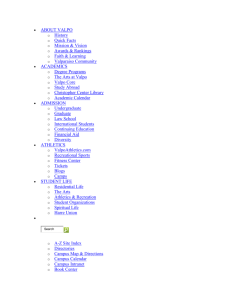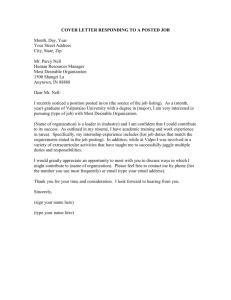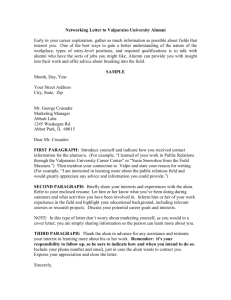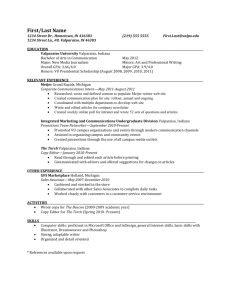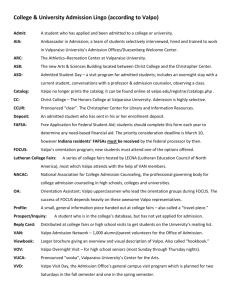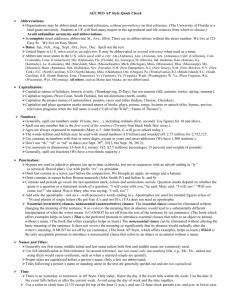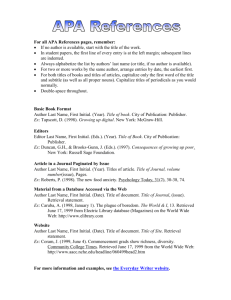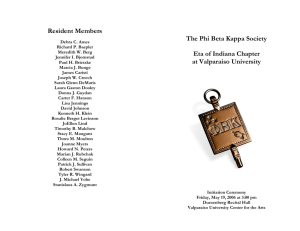Editorial Style Guide - Valparaiso University
advertisement
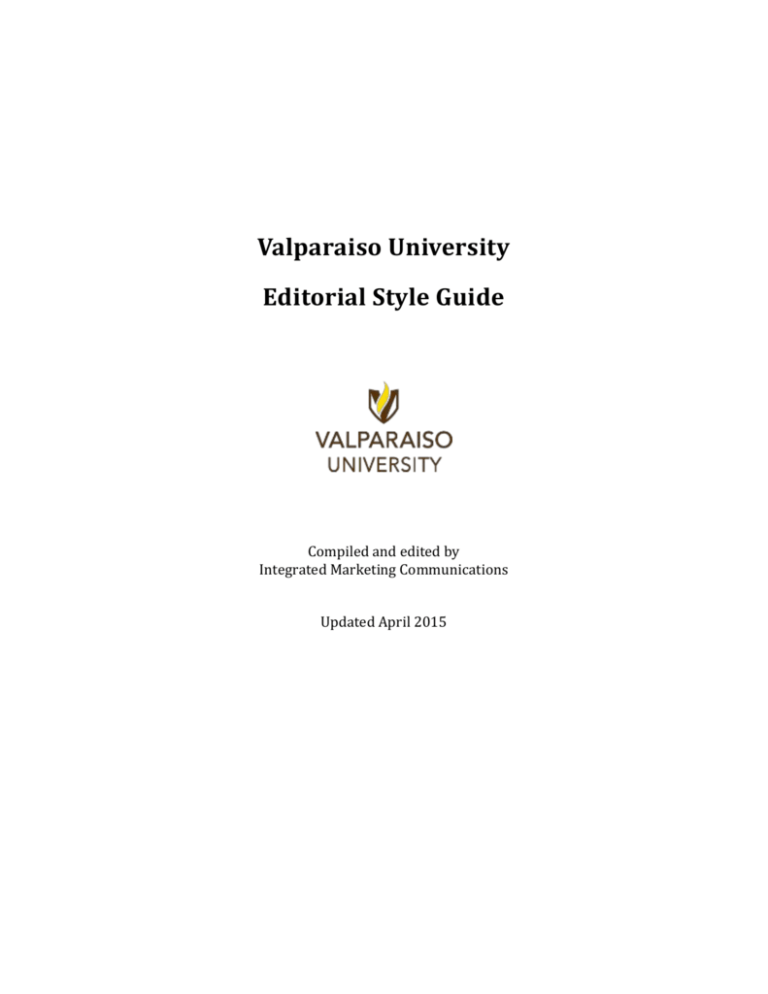
Valparaiso University Editorial Style Guide Compiled and edited by Integrated Marketing Communications Updated April 2015 The following guidelines follow Associated Press and Chicago Manual of Style. This style should be used for all marketing, web, and PR pieces developed for Valparaiso University. For style questions not referenced here, consult the Associated Press Stylebook. In general: Always use Valparaiso University, Valpo, or the University when referring to Valparaiso University. Do not use Valparaiso, VU, or Valpo University. Never break the word Valparaiso, University, or Valpo. Capitalize University as a standalone when referring to Valparaiso University. Lowercase university when using as an adjective or Valparaiso University could not take its place in the sentence i.e., when used generally or to refer to other universities. Use one space after a period (or sentence ending punctuation) before the start of the next sentence. Use serial commas in all marketing materials. Omit the serial comma only for materials sent to media outlets. Example: students, faculty, and staff Use a space before and after em dash or ellipses. Review the document to ensure the type font is consistent for text, headers and headlines. It is recommended that font size be set at 10-point font or larger. 2 a, an — Use the article a before consonant sounds and an before vowel sounds. Example: a historic event an homage abbreviations and acronyms — Never use V.U. or VU as an acronym for Valparaiso University. VU can refer to a multitude of universities; Valpo or Valparaiso University is preferred. Avoid acronyms unless they are widely recognized. Use capitalized letters and no periods when individual letters are pronounced. Example: FBI, CIA academic degrees — Lowercase if spelled out, such as bachelor of arts, master of science, doctorate, or doctor of philosophy. Do not follow the full name of a degree with the word degree. Use an apostrophe in the short form, such as bachelor’s degree, or master’s. Example: Right: She received a master of arts in communication. Right: She received a master’s degree in communication. Wrong: She received a master of arts degree in communication. Use periods for two-letter degrees, such as B.A., B.S., M.A., J.D., etc. In general, do not use periods for degree abbreviations with three or more capital letters, such as MBA, MFA, or MALS. When used after a name, a degree abbreviation is set off in commas. Undergraduate Programs Abbreviation B.A. BFA B.M. B.S. Master’s Programs Abbreviation M.A. MALS M.S. MBA M.Ed. MEM MFA MHA LL.M. MLS MLIS MMA M.M. Full Official Name Bachelor of Arts Bachelor of Fine Arts Bachelor of Music Bachelor of Science Full Official Name Master of Arts Master of Arts in Liberal Studies Master of Science Master of Business Administration Master of Education Master of Engineering Management Master of Fine Arts Master of Health Administration Master of Laws Master of Library Science Master of Library and Information Science Master of Ministry Administration Master of Music 3 MPH MSW Doctorate Programs Abbreviation Ed.D. J.D. LL.D. M.D. DNP Ph.D. Th.D. Master of Public Health Master of Social Work Full Official Name Doctor of Education Juris Doctor Doctor of Laws Doctor of Medicine Doctor of Nursing Practice Doctor of Philosophy Doctor of Theology academic subjects — Avoid capitalizing an academic subject when it is used as a general field of study. Capitalize academic subjects when they are part of the official title of a University entity, when they are the name of a language, and when they are the official title of a course or a short title that includes the course number. Example: The Department of Communication offers programs in advertising, journalism, telecommunications, and public relations. She majored in mechanical engineering and minored in German. She teaches in the communication department. academic year — An academic year straddles two calendar years. Use the complete, fourdigit year and connect with an en dash. Do not use school year. Example: The 2014–2015 academic year kicked off with the annual Opening Convocation. acreage — Valpo’s campus is more than 350 acres. addresses — In running copy, abbreviate directional ends of streets such as north and abbreviate Ave., Blvd., and St. when used with a numbered address or a block number. Spell out and capitalize when used without a numbered address. Lowercase and spell out when used with more than one street name. Do not abbreviate alley, drive, road, terrace, etc. Valpo’s address: 1700 Chapel Drive Valparaiso, IN 46383-6493 admission — Refers to the Office of Undergraduate Admission. advisor — Use advisor, not adviser, for academic advisors. 4 affect, effect — Use affect as a verb meaning to influence. Use effect as a noun meaning a result or consequence or as a verb meaning to bring about or to cause. Example: The winter storm will affect the class schedule. The storm had no effect on the class schedule. Valpo students hope to effect change in their communities. African American — Preferred term. See also inclusive writing. ages — Use figures. When used as a modifier or a noun, use hyphens. See also numbers. a la carte — Do not hyphenate or use accent mark. Alliance — Student group that advocates for LGBTQ youth and their allies. all ready, already — Use all ready as an adjective to mean completely ready. Use already as an adverb to mean before then. all right alma mater — In formal publications, such as programs for Commencement and dedication ceremonies, use the first and third verses of Valpo’s alma mater. Include attribution after verse text. Hail to the Brown and Gold! Hail to the Brown and Gold! Thy sons and daughters hold We pledge thee to uphold — In loving loyalty Wherever we may be — Thy colors dear; Thy honored name. Colors whereby they show Through years that come and go, What others, too, should know; To pay the debt we owe, That they belong to you, We’ll e’er be true to you, Dear old Valpo. Dear old Valpo. Text: Helen Dvorak, Oscar C. Kreinheder, and Harold Rogers Music: J. F. Petri, How Can I Leave Thee a lot Alpha Lambda Delta — The freshman honor society. alumna — Singular, female. alumnae — Plural, females. alumni — Plural, males or males and females. alumnus — Singular, male. 5 Use an alum’s complete name on first reference and first name on subsequent references. For honorary alumni, use last name after the first reference. The punctuation before the year is an apostrophe. Do not use a comma between the name and the graduate year. Example: Male or female (Use when name was the same as when she or he was a student) Married female (Use only when the name was different as when she was a student) Multiple degrees (List the degree in the order it was received) Alum who received postsecondary degree after Valpo Familiar nickname First Last ’YR Andrew N. Nunemaker ’91 Louise Williams ’67 First Maiden ’YR Last Katie Shaw ’11 M.Ed. Kortokrax First Last ’YR, ’YR DE1 Tom Wyatt ’94, ’12 M.S. Toni Baldwin-Dufour ’95, ’97 MSN, ’10 DNP Eric Johnson ’87, Ph.D. Alumni couples (Same last name) Female Maiden ’YR and Male Last ’YR Alumni couples (Different last names) Couples when one is deceased Couples when only one is alumnus Honorary degrees Person with Initials Female Last ’YR and Male Last ’YR First Last ’YR, DE First “Nickname” Last ’YR First Last ’YRH I. First Last Ginger “Zee” Zuidgeest ’02 Moninder “Holly” Singh ’98, ’05 MALS Leslie Hallman ’77 and Tim Paul ’76 Phyllis Buehner ’54 and Richard Duesenberg ’51, ’53 J.D. Katherine Wehling ’83 J.D. and Curt Cichowski, ’81 J.D. Margaret Franson ’89 MALS and the late John Paul ’73 Anne Marie Vicari ’82, ’85 J.D. and Walter Diambri Lois Mitchum ’06H N. Cornell Boggs III ’82, ’85 J.D. a.m., p.m. — Lowercase, with periods. Use figures to designate time using a.m. and p.m. Avoid redundancy such as 10 a.m. this morning. See also time. 1 DE = degree earned 6 America — Do not use when referring to the United States. ampersand — Spell out the word and instead of using the ampersand symbol & in running text. Exception: formal company names such as US News & World Report. The ampersand symbol is acceptable in list or table form or as a design element. annual — Do not use the phrase first annual. An event cannot be described as annual until it has been held at least two successive years. apostrophes — Use the apostrophe to indicate possession, not plurality. Exception: Plurals of single letters do use an apostrophe. Example: Mind your p’s and q’s. Plurals of figures do not use an apostrophe. Example: 1950s Do not use apostrophe s after proper names ending in s. Example: Right: Jesus’ Wrong: Jesus’s Be sure to use the apostrophe ’ and not the single open quote ‘ or the footmark ', which is straight, not curly. Asian American — Preferred term. See also inclusive writing. Asian American Association — Student organization that promotes awareness of diverse Asian American cultures. Athletics — Capitalize proper names and lowercase general team names. Example: Valparaiso Crusaders men’s basketball team back up (v.), backup (n and adj.) Bible, biblical — Capitalize Bible when referring to the religious text. Lowercase biblical in all instances. Never put a space after the colon in a biblical citation. Right: Psalm 23:1 Wrong: Psalm 23: 1 Black Student Organization (BSO) — Student organization that promotes pride and cultural awareness of African American culture. Board of Directors — Capitalize when referring to Valparaiso University’s Board. bookstore 7 buildings — See campus locations. bulleted lists — If the lead-in statement is a complete sentence, use a colon at the end to introduce the list. If the lead-in statement is a sentence fragment, don’t use a colon. If the list item is a complete sentence, capitalize the first letter. If the list item isn’t a complete sentence, choose whether or not to capitalize the first letter and be consistent. If the list items are complete sentences, or if at least one list item is a fragment that is immediately followed by a complete sentence, use normal terminal punctuation: a period, question mark, or exclamation point. List items should be parallel. If one bullet point starts with a verb, then start every bullet point with a verb. Example: Valpo will host several events this holiday season: Advent–Christmas Vespers Christmas Concert TUBACHRISTMAS Events include Advent–Christmas Vespers Christmas Concert TUBACHRISTMAS The physics department strives to communicate knowledge and its limitations, motivate students to achieve a greater understanding, overcome widespread scientific illiteracy, and promote the development of morally responsible citizens. The physics department has several objectives: It will communicate knowledge and its limitations. It will motivate students to achieve a greater understanding. It will overcome widespread scientific illiteracy. It will promote the development of morally responsible citizens. campus locations Alumni Hall (Residence) College of Arts and Sciences Building Athletics-Recreation Center (ARC) Art-Psychology Beacon Hall (Residence) Brandt Hall (Residence) Brauer Museum of Art (located in the Center for the Arts; Brauer Museum after first reference) Brown Field Center for Diaconal Ministry 8 Chapel of the Resurrection (Chapel after first reference) Christopher Center for Library and Information Resources (CCLIR) Confucius Institute Dickmeyer Hall Domke Center Donald V. Fites Engineering and Innovation Center (Fites Center after first reference) Doppler radar Duesenberg Welcome Center (Welcome Center after first reference) Emory Bauer Field Facilities Management Fitness Center Gellersen Engineering and Mathematics Center (College of Engineering — Gellersen after first reference) Guild Hall (Residence) Harre Union Health Center (Promenade East) Heidbrink Hall Henrichs House Heritage Hall (Law Clinics) James S. Markiewicz Solar Energy Research Facility Kade-Duesenberg German House and Cultural Center Kallay-Christopher Hall Kretzmann Hall (O.P. Kretzmann Hall) Kroencke Hall Lankenau Hall (Residence) LeBien Hall (Nursing and Health Professions) LeBien Hall Annex Linwood House Loke Hall Meier Hall Memorial Hall (Residence) Meuller Hall (Christ College – The Honors College) Neils Science Center Neils Science Center Observatory Parking Ramp East Parking Ramp West Scheele Hall (Residence) Schnabel Hall Soccer and Intramural Fields Softball Field Tennis Complex University Mail Center The Uptown East Apartments Urschel Hall (College of Business) Center for the Arts 9 Valparaiso University Police Department Warren G. Hoger Track Wehrenberg Hall (Residence) Wesemann Hall (Law School) campuswide cancel, canceled, canceling, cancellation Career Center caregiver catalog century — Lowercase, spelling out numbers less than 10. Hyphenate when used as an adjective. Example: In the first century Literature from the 20th century 20th-century literature ceremonies and celebrations — Capitalize Valpo’s major ceremonies: Opening Convocation, the Taste of Valpo, Homecoming and Reunion Weekend, Baccalaureate, Commencement. chair — Preferred title for the presiding officer of a department or committee. Chapel of the Resurrection — Spell out as Chapel of the Resurrection on the first reference, then capitalize Chapel in subsequent references. child care Christ College — The Honors College — Use the full name on the first reference. Subsequent references may be Christ College. class year — Always include a student or alum’s class year and capitalize Class of. co-curricular College of Arts and Sciences College of Business — Not College of Business Administration. College of Engineering 10 College of Nursing and Health Professions — not College of Nursing. colon — The most frequent use of a colon is at the end of a sentence to introduce lists, tabulations, texts, etc. The first word after a colon should be capitalized if a proper noun or the start of a complete sentence. Do not use a colon to set off a list of single words or simple phrases. A colon may be used to set off a bulleted list or a list composed of long phrases. Example: The Department of Physics and Astronomy strives to: communicate knowledge and its limitations, motivate students to achieve a greater understanding of scientific inquiry, overcome widespread scientific illiteracy, and promote the development of morally responsible citizens. commas — Use serial commas to set off items in a list. Example: Christ College students are also enrolled in the Colleges of Arts and Sciences, Business, Engineering, and Nursing and Health Professions. Use a comma to separate two or more adjectives equal in rank preceding a noun. If the adjectives can be reversed without changing the meaning of the sentence, they have equal rank, and a comma is needed. Example: The summer was a long, hot season. She wore a cheap wool coat. A comma is not used to separate a name and Jr. or Sr. or a name and a numeral. For example: John D. Rockefeller III Martin Luther King Jr. Use commas to separate independent clauses of a compound sentence. Example: Valpo consistently earns recognition from national and regional rankings, and the University was recently named one of the top 100 colleges in the Midwest by Forbes Magazine. Do not use a comma if the conjunction does not combine two independent clauses. Example: Valpo consistently earns recognition from national and regional rankings and was recently named one of the top 100 colleges in the Midwest by Forbes Magazine. Use commas to set off the elements in addresses and names of geographical places. Example: The campus is located in Valparaiso, Ind., an hour from Chicago. When month, day, and year are included in a date in running text, use commas before and after the year. Example: The academic year began Aug. 26, 2014, with Opening Convocation. 11 Any word, phrase, or clause that is not essential to the meaning of a sentence is called nonrestrictive, and a comma should be used to set it apart. Example: The Brauer Museum, which is located in the Center for the Arts, features prominent artists such as Georgia O’Keeffe. Restrictive words, phrases, or clauses are necessary to the meaning of a sentence and are not set off by commas. Example: Shakespeare’s play Othello was presented at the theatre. Use a comma after an introductory phrase with five or more letters. Introductory phrases do not have both a subject and a verb that are separate from the subject and verb in the main clause of the sentence. Example: To stay in shape for competition, student-athletes must exercise every day. Commencement — Capitalize when referring to the official Valparaiso University Commencement. Lowercase when used generally or as an adjective. Example: Valparaiso University’s Commencement will be cybercast live. A university’s commencement is a special occasion. committee — Capitalize when using a full committee’s name. Lowercase otherwise. company names — For a company’s formal name, consult the national stock exchanges: the New York Stock Exchange, nyse.com, or Nasdaq, nasdaq.com. Do not use a comma before Inc., Ltd. LLC, or LLP, even if it is included in the formal name. Do not use all-capital-letter names unless the letters are pronounced individually. Otherwise, use uppercase and lowercase. Example: BMW USA Today Ikea Do not use symbols such as exclamation points, plus signs, or asterisks that form contrived spellings that might distract or confuse a reader. Example: Right: Yahoo, Toys R Us Wrong: Yahoo!, Toys “R” Us Use an ampersand only if it is part of the company’s formal name. Lowercase the unless it is part of the company’s formal name. composition titles — Follow AP Style for book titles, journal article titles, computer game titles, movie titles, opera titles, play titles, poem titles, album and song titles, radio and television program titles, and titles of lectures, speeches, and works of art. Capitalize the principal words, including prepositions and conjunctions of four or more letters. 12 Capitalize an article — the, a, an — or words of fewer than four letters if it is the first or last word in a title. Put quotation marks around the names of all such works except the Bible and books that are primarily catalogs of reference material. In addition to catalogs, this category includes literary and academic journals, almanacs, directories, dictionaries, encyclopedias, gazetteers, handbooks, and similar publications. Examples: “The Star-Spangled Banner” “How Great Thou Art” “Gone With the Wind” “Of Mice and Men” the “CBS Evening News” Journal of Values-Based Leadership continual, continuous — Continual means habitual, frequently recurring. Continuous means ongoing, without interruption. Core — A two-semester long, interdisciplinary course called “The Human Experience” for all first-year students. course titles — Capitalize official course titles in running text. Do not use italics or quotation marks. Example: Introduction to Biology When listing a course number with the departmental abbreviation, put a space between the abbreviation, the course number, and the course name. Example: PSY 202 Research Methods in Psychology coursework courtesy titles — Do not use courtesy titles such as Mr., Mrs., Ms., etc. Use Dr. only when the person is a medical doctor. Exception: For formal publications with biographies, such as the Board of Directors dinner script, include courtesy titles to remain consistent with other biographies that may include titles such as President or Provost. See also names and titles. credit hours — Use numerals to refer to credit hours. May be abbreviated as cr. in tabular format. Crusaders – The University’s athletic teams are formally called the Crusaders. When used as an adjective, use the singular form (e.g., Crusader spirit). curriculum, curricula 13 dash — The em-dash expresses a pause, an abrupt change in thought, or a parenthetical statement. A space should separate a dash from the word preceding and the word following it. Example: Year after year — for more than 20 years — more than 90 percent of Valpo graduates are employed or attend graduate school within six months of graduation. The en-dash is half the length of an em-dash and longer than a hyphen. It is used to indicate a range or to express a connection between two things of equal weight. Example: The exhibition runs January–March. Civil War–era literature database dates — Always use Arabic figures, without st, nd, rd, or th. Use an en dash to show a range of dates. Use the complete, four-digit year. When a phrase refers to a month, day, and year, commas are required before and after the year. Example: The event was held May 20, 2013, in Valparaiso. When including a day of the week with the date, use a comma after the day and after the date. Example: The reception will be Wednesday, Oct. 1, at 5 p.m. When referring to the month and year, do not use a comma. Example: The May 2014 issue is available now. See also days and months and times. days — Do not abbreviate days of the week unless in tabular format. When writing a day and date, use a comma after the day and after the date. Example: The play opens Thursday, Oct. 30, at the University Theatre. Do not set off days or dates in commas when they stand alone. Example: The play opens Oct. 30 at the University Theatre. For online publications, include the date, not just the day, so that the information remains timely and clear. dean — Capitalize when used as a formal title before a name. Lowercase in other uses. See also names and titles. decades — Use figures to indicate decades. When abbreviating, precede with an apostrophe, not a single quotation mark. Form the plural by adding the letter s, no apostrophe. 14 Example: Right: ’20s, ’60s, 1960s Wrong: 20’s, 1960’s degrees — See academic degrees departments, academic — Capitalize only when using the full, formal name of a department. Lowercase in other forms. Languages are always capitalized, regardless of formatting. Example: Department of Chemistry chemistry department French department departments and offices, administrative — Capitalize when referring to an official University department or office. Avoid using department of or office of, as this can feel institutional and less personal. Example: Admission Advancement Lowercase other forms. Example: undergraduate admission office registrar’s office dimensions — Use figures and spell out inches, feet, yards, etc. Example: He is 5 feet 6 inches tall. The 9-by-12 stage. directions and regions — Lowercase north, south, southeast, etc. when they indicate compass directions. Capitalize when they designate regions. Example: the north side of campus The campus is in Northwest Indiana. disabled, disability — Preferred terms, rather than handicapped. See also inclusive writing. dorm — Use residence hall instead of dorm when referring to Valpo living quarters. Dr. — May be used as a title before the name of a medical doctor on first reference. each — Takes singular verb. Example: Each of the students is invited to the reception. 15 Earthtones – Campus environmental awareness group. e-book, e-business, e-commerce, e-reader — Use hyphen. effect, affect — Use affect as a verb meaning to influence. Use effect as a noun meaning a result or consequence or as a verb meaning to bring about or to cause. Example: The winter storm will affect the class schedule. The storm had no effect on the class schedule. Valpo students hope to effect change in their communities. e.g., i.e. — Use e.g. to say for example. Use i.e. for that is. Both are followed by commas. Example: There are many new buildings on campus, e.g., Beacon Hall and the Welcome Center. Because web content is not static (i.e., it changes often), it’s important include dates for events rather than simply using the day of the week. either — Takes singular verb. Example: Either of the two rooms has sufficient seating. ellipsis — Three dots used to indicate a pause or to indicate word(s), sentence(s), or paragraph(s) omitted from quoted material. Ellipsis should be preceded and followed by a space. email (n. and v.) email addresses — Lowercase. Example: imc@valpo.edu mark.heckler@valpo.edu emerita — Singular female. emeriti — Plural. emeritus — Singular male. Engineers Without Borders – Service-based organization open to all majors. endowed chairs — Named chairs and professorships are always capitalized in faculty titles, whether preceding or following the name of the faculty member. Examples: Lorraine S. Brugh, Ph.D., Kruse Organist Professor 16 Mark M. Budnik, Ph.D., Paul and Cleo Brandt Professor of Engineering Gretchen Buggeln, Ph.D., Phyllis and Richard Duesenberg Chair in Christianity and the Arts Martin Buinicki, Ph.D., Walter G. Friedrich Professor of American Literature Christopher M. Cock, Ph.D., Phyllis and Richard Duesenberg Chair in Lutheran Music Nina M. Corazzo, Ph.D., Walter E. Bauer Professor of Art History Dennis Friesen-Carper, Ph.D., Frederick A. and Mazie N. Reddel Professor of Music Christoffer H. Grundmann, Ph.D., John R. Eckrich University Chair in Religion and the Healing Arts Sami Khorbotly, Ph.D., Frederick F. Jenny Professor of Emerging Technology Rosalie Berger Levinson, J.D., Phyllis and Richard Duesenberg Chair in Law Kristen L. Mauk, Ph.D., DNP, Kreft Endowed Chair for the Advancement of Nursing Science John A. Nunes, Ph.D., Emil & Elfriede Jochum University Chair Robert Palumbo, ’80, Ph.D., Alfred W. Sieving Chair of Engineering George Pati, Ph.D., Surjit S. Patheja, M.D. Chair in World Religions and Ethics Ronald Rittgers, Ph.D., Erich Markel Chair in German Reformation Studies Dean Schroeder, Ph.D., Herbert H. and Agnes S. Schulz Professor of Business Timothy Tomasik, Ph.D., Richard P. Baepler Distinguished Professor in the Humanities P. Douglas Tougaw, Ph.D., Leitha and Willard Richardson Professor of Engineering entitled — The right to have or do something. Do not use to refer to the title of a book, article, presentation, etc. Instead, use titled. essential and nonessential clauses — An essential (or restrictive) clause is essential to the meaning of the sentence. No comma should be used with an essential clause. A nonessential (or nonrestrictive) clause is not essential to the meaning of the sentence but provides additional information. In general, that introduces essential clauses and no comma is used. Use which to introduce nonessential clauses and set off the clause with commas. See also that, which. etc. — Use sparingly. Should be preceded by a comma. Evangelical Lutheran Church in America (ELCA) exclamation point — Use sparingly. Never use in a news release. extracurricular faculty — Refers to the collective body. Use faculty member(s) for individual(s). 17 faculty members — Titles following names are lowercased, with the exception of named chairs or professorships. See also names and titles. FAFSA — Free Application for Federal Student Aid. Students are encouraged to complete this application to qualify for grants, loans, and work-study funds. fall break, fall semester — Lowercase. FAQ — Acceptable to use abbreviation for frequently asked questions. farther, further — Farther refers to physical difference. Further refers to an extension of time or degree. Example: Many people believe Valparaiso is farther away from Chicago than it actually is. She returned to school to further her education. federal — Lowercase unless part of proper name. fewer, less — Use fewer to describe number of items, less to describe quantity. Example: There are fewer pages in this document. There is less content in this document. firsthand first-year, freshman (adj.) — First-year is often preferred to include transfer students. fiscal year — Valparaiso University’s fiscal year is from July 1 to June 30. When abbreviating, use FY and the calendar year the fiscal year ends. Example: FY2016 runs from July 1, 2015, through June 30, 2016. FOCUS — Valpo’s new-student orientation foreign students — Use international students instead. fraternities and sororities — Use sorority and fraternity community instead of Greek Life. National social fraternities: Lambda Chi Alpha; Phi Delta Theta; Phi Kappa Psi; Phi Mu Alpha Sinfonia; Phi Sigma Kappa; Sigma Chi; Sigma Phi Epsilon; Sigma Pi National social sororities: Chi Omega; Gamma Phi Beta; Kappa Delta; Kappa Kappa Gamma; Pi Beta Phi 18 freshman — Use this singular form (not plural, freshmen) as the adjective. Example: the freshman representative; freshman residence hall fundraiser, fundraising Gamma Theta Upsilon — International honor society in geography. Valpo’s chapter is Alpha Xi. GPA — No periods, all capitals. Guild — see Valparaiso University Guild. headlines — Capitalize each word except articles, coordinating conjunctions, and prepositions with fewer than five letters. health care Homecoming and Reunion Weekend — Capitalize and use full name on first reference. Homecoming is acceptable after first reference. home page Horizon League — The name of Valparaiso University’s athletic conference (except for football and bowling). hyphen — Hyphens are used inside words to separate their parts from each other. This includes using the hyphen between the parts of a compound word in which two or more words express a single concept. When a compound modifier — two or more words that express a single concept — precedes a noun, use hyphens to link all words in the compound except the adverb very and all adverbs that end in –ly. Example: full-time employment federally funded research Use a hyphen when writing out fractions. Example: The proposal requires a two-thirds vote to pass. i.e., e.g. —Use i.e. for that is. Use e.g. to say for example. Both are followed by commas. Example: There are many new buildings on campus, e.g., Beacon Hall and the Welcome Center. Because web content is not static (i.e., it changes often), it’s important include dates for events rather than simply using the day of the week. 19 inclusive writing/nondiscrimination — Inclusive language does not demean, insult, exclude, stereotype, or trivialize people on the basis of their disability, race or gender. It avoids terminology that may be offensive or portray any group in a stereotypical way. Terms that refer to personal attributes such as race, gender, sexual orientation, disability or age, for example, tend to over-emphasize and draw undue attention to the distinguishing attribute. Avoid the use of such descriptors unless they are relevant and valid. Age and class rank: Terms such as older and younger are relative and should be used with clarity and in context. Avoid any stereotyping or connotation that a particular age group is more or less able or has specific characteristics by virtue of chronological age alone. Avoid using expressions such as a young and vibrant team or a mature workforce. Instead, try an effective and vibrant team or an experienced workforce. If appropriate, use first-year students instead of freshmen. Using juniors and seniors is preferred to upperclass students. Disability: Often people with a disability are referred to collectively as the disabled, the handicapped, the blind, the deaf, etc. These terms have the effect of depersonalizing the description of people and equating the person with the disability. Be careful not to imply that people with disabilities are to be pitied, feared, or ignored, or that they are somehow more heroic, courageous, patient, or special than others. Never use the terms normal or able-bodied in contrast. Do not describe an individual as disabled or handicapped unless it is clearly pertinent to a story. Avoid euphemisms such as mentally challenged and descriptions that connote pity, such as afflicted with or suffers from. Do not use normal to mean the opposite of having a disability. Avoid words like victim, afflicted, and stricken. Strive for person-first language. Example: Right: Person with a disability Wrong: Disabled person Gender: Do not use “he” when referring to an unspecified person. Instead, rewrite the sentence into the plural or avoid the use of pronouns altogether. Example: Right: Students applying for financial aid should file their applications for admission by Jan. 1. Wrong: A student applying for financial aid should file his application for admission by Jan. 1. When reference to a specific gender is necessary, women and men are the preferred titles. The terms girls and boys should only be used for females and males under age 12. Use alternatives for gender-specific occupation terms. Example: Right: Chair, chairperson 20 Wrong: Chairman Avoid terms such as manpower, manning, fellow, etc. Race and Ethnicity: Use international students instead of foreign students. Do not hyphenate African American, Asian American, American Indian, etc. Capitalize the proper names of nationalities, peoples, races, and tribes. (e.g. Arab, Cherokee, Japanese, Jewish.) Because members of some ethnic groups use different terms when referring to themselves, if possible ask how they would like to be identified. African American — the usage of the cultural-ethnic background of people who were transplanted to the Americas is preferred, rather than referencing skin color. This usage affirms the rich ethnic traditions from which people have come rather than simply indicating skin color or a perceived skin color. Do not hyphenate as a noun or an adjective. African Descent — people whose ancestors, however long ago, came from Africa Alaska Native — indigenous people of Alaska American Indian — indigenous people of North America, except for those identified as Alaska Native people. Native American is also acceptable. Asian — use for people from countries in Asia. Do not use Asiatic or Oriental. Whenever possible, make references to the specific country. Asian American — United States citizens of Asian descent Indian — use only for a person from India Latino (m. or collective), Latina — preferred to Hispanic. When possible, use more specific identification. (e.g. Cuban, Puerto Rican, Mexican American.) Sexual Orientation: Do not assume heterosexual orientation or imply that sexual orientation is a voluntary choice. Use sexual orientation, not sexual preference or lifestyle choice. Refer to the following glossary from the Human Rights Campaign2 to ensure clarity and accuracy: Bisexual — A person emotionally, romantically, sexually and relationally attracted to both men and women, though not necessarily simultaneously; a bisexual person may not be equally attracted to both sexes, and the degree of attraction may vary as sexual identity develops over time. Coming Out — The process in which a person first acknowledges, accepts and appreciates his or her sexual orientation or gender identity and begins to share that with others. Gay — A word describing a man or a woman who is emotionally, romantically, sexually and relationally attracted to members of the same sex. Gender Expression — External manifestation of one’s gender identity, usually expressed through masculine, feminine or gender-variant behavior, clothing, haircut, voice or body characteristics. Typically, transgender people seek to make their gender expression match their gender identity, rather than their birthassigned sex. 2 http://www.hrc.org/resources/entry/glossary-of-terms 21 Gender Identity — One’s personal sense of their gender. For transgender people, their birth-assigned sex and their own sense of gender identity do not match. Genderqueer — A word people use to describe their own non-standard gender identity or expression. Lesbian — A woman who is emotionally, romantically, sexually and relationally attracted to other women. LGBT — An acronym for lesbian, gay, bisexual, and transgender. Queer — Often used interchangeably with LGBT. Be mindful that the term may have negative or derogatory connotations for some people; however, many younger people are comfortable using it. Again, ask the person how she or he identifies and use that term. Sexual Orientation — An inherent or immutable enduring emotional, romantic, sexual and relational attraction to another person; may be a same-sex orientation, opposite-sex orientation or a bisexual orientation. Transgender — A term describing a broad range of people who experience and/or express their gender differently from what most people expect. It is an umbrella term that includes people who are transsexual, cross-dressers or otherwise gender non-conforming. Transsexual — A medical term describing people whose gender and sex do not line up, and who often seek medical treatment to bring their body and gender identity into alignment. Avoid using this term unless an individual self-identifies as transsexual. Interfraternity Council (IFC) — Umbrella organization for Valpo fraternities. Promotes self-governance and oversees recruitment. Internet Jr. — Do not precede with comma. justification — Left justification is preferred over full justification. When necessary, alternative justification choices may be used at the discretion of the designer. Law School — Not School of Law. lectures — Capitalize the name of a lecture series. Use quotation marks for the titles of individual lectures. Example: Mary Szybist’s lecture, “Readings from Incarnadine” is part of the Christ College Symposium Series. LEED — Commonly known acronym for Leadership in Energy and Environmental Design, which consists of a suite of rating systems for the design, construction, and operation of high performance green buildings, homes, and neighborhoods. 22 Lilly Fellows Program in Humanities and the Arts — Largest ecumenical organization that endeavors to renew and enhance the connections between Christianity and the academic vocation at church-related colleges and universities. line breaks — Never break the word Valpo, Valparaiso, or University. Avoid ending two or more consecutive lines with hyphenated words. Hyphenated words should have no fewer than four letters before and after the hyphen. LIVE —Latinos in Valparaiso for Excellence promotes academic excellence among Hispanic students and supports and cultivates interests of Latino students through activities. Lutheran Church — Missouri Synod, The (LCMS) majors, minors — Do not capitalize academic majors or minors unless they include a proper noun such as a language. Master Plan — Established to develop Valpo’s physical environment throughout the next 20 years. Major elements of the development process include landscape and architectural development. Capitalize Master Plan when referring to the official plan. months — Some months are abbreviated when used in an exact date. Months with fewer than six letters are not abbreviated. Abbreviations: Jan., Feb., Aug., Sept., Oct., Nov., Dec. Months are spelled out when used alone or with the year only. Months may be spelled out when used in a formal invitation. more than, over — Use over to describe spatial relationships; use more than with figures. multicultural names and titles — Capitalize and spell out formal titles such as professor or dean when they precede a name. Lowercase elsewhere. Do not use a courtesy title such as Mr. or Ms., except for medical doctors. Example: Dean Eric W. Johnson ’87, Ph.D. Eric W. Johnson ’87, Ph.D., dean Computer and Electrical Engineering Chair and Professor Jeff Will, Ph.D., received the 2014 ASEE National Outstanding Teaching Medal. Jeff Will, Ph.D., computer and electrical engineering chair and professor, received the 2014 ASEE National Outstanding Teaching Medal. In press releases and other items sent to the media, follow AP Style. For storytelling (web features, newsletters, etc.), use Professor/Dean/Provost/Coach Lastname on subsequent references. Example: 23 Jeff Will, Ph.D., computer and electrical engineering chair and professor, received the 2014 ASEE National Outstanding Teaching Medal. Professor Will has been with the University for 13 years. Titles may be capitalized after the name when used in a headline, directory, or listing. For students and alumni, use full name with graduation year on first reference and first name only for subsequent references. See also alumni. Native American — One of the descendants of the indigenous peoples of North America. Avoid the term Indian. Do not hyphenate as noun or adjective. neither — Takes a singular verb. newspaper and periodical names — Names of newspapers and periodicals are capitalized. Do not use italics or quotation marks. See also composition titles. nonprofit noon — Do not put a 12 in front of it. See also a.m., p.m. and midnight. numbers — Spell out whole numbers below 10 or at the beginning of a sentence; use figures for 10 and above. For ordinals, spell out first through ninth; starting with 10th, use figures. Exception: for percentages, dimensions, and ages, use figures, even for 1-9. Use a comma in numerals of 1,000 and above except for temperatures, years, street addresses, broadcast frequencies, room numbers, serial numbers, and telephone numbers. For figures greater than 999,999, use million or billion. Example: 2.3 billion, 4 billion Spell out fractions in text material. Hyphenate fractions when they are used as adjectives or adverbs. Example: The book is three-fourths complete. In a list, a fraction and a whole number appear as numerals with a space between. Example: 3½ When using ratios in a sentence, use a hyphen instead of a colon. Example: 12-to-1 A colon is acceptable for ratios in list form. Example: 12:1 An en dash should not be used as a substitute for to in a range unless the numbers are in parentheses. 24 Example: She taught at Valpo from 1980 to 2000. She taught at Purdue University (1960–1965), Northwestern University (1965–1980), and Valparaiso University (1980–2000). Use periods to separate numerals in phone numbers. Do not use parentheses for the area code. Abbreviate ext. and separate from the phone number. Example: 219.464.5000, ext. 1234 For internal calls, use only the extension number Example: ext. 1234 offline on-campus, on campus — Use on-campus as an adjective and on campus as a prepositional phrase. Example: On-campus events are held throughout the year. Events are held on campus throughout the year. online Opening Convocation — Ceremony marking the beginning of the academic year. Order of Omega — National Greek leadership honor society. Orientation Assistant — Spell out on first reference, then abbreviate OA. over, more than — Use over to describe spatial relationships. Use more than with figures. Panhellenic Council — Coordinates sorority recruitment process and other aspects of sorority organization. parentheses — Place a period outside a closing parenthesis if the material inside is not a sentence. Place the period inside the closing parenthesis if the material inside is a complete sentence. part-time, part time — Hyphenate as an adjective. Otherwise, two words, no hyphen. Example: She is a part-time employee. She works part time. PDF — Abbreviation for portable document format. Use all uppercase unless appended to a file name to designate the type of file extension. Example: She emailed a PDF of the design. The file name is draft.pdf. 25 percent — Spell out the word percent; do not use the symbol unless in a list or table. Use figures. period — Use to indicate the end of a declarative or imperative sentence and follow with single space. Periods always go inside quotation marks. Phi Beta Kappa Society — National society honors academic excellence and scholarly achievement in liberal arts and sciences. Valpo chapter is Eta of Indiana. Phi Mu Alpha Sinfona — National music fraternity. Valpo’s chapter is Kappa Sigma. p.m., a.m. — Lowercase, with periods. Use figures to designate time using a.m. and p.m. For noon and midnight, use the words noon and midnight without the figure 12. Avoid redundancy such as 10 a.m. this morning. See also time. police department — Use Valparaiso University Police Department as official name. Do not abbreviate as VUPD. May be referred to as University police. president — Mark A. Heckler, Ph.D., has served as Valparaiso University’s 18th president since 2008. Do not use Ph.D. when President precedes his name. Example: Mark A. Heckler, Ph.D., president President Mark A. Heckler President’s Council — Administrators who report to the president and oversee broad areas of the University’s operations in support of the Strategic Plan. Members: Richard A. AmRhein ’12 J.D., Chief of Staff and Chief Information Officer Mark L. Biermann, Ph.D., Provost and Executive Vice President for Academic Affairs, Professor of Physics and Astronomy Darron C. Farha, J.D., Vice President and General Counsel Mark A. Heckler, Ph.D., President Lisa Hollander, B.A., Vice President for Advancement Bonnie Hunter, Ph.D., Vice President for Student Affairs Brian T. Johnson, M.Div., Executive Director of Campus Ministries Michael A. Joseph, M.A., Vice President for Enrollment Management John A. Palmucci Jr., MBA, Senior Vice President for Finance and Administration Susan D. Scroggins, CPA, ’04 MBA, Vice President for Administration professor — Capitalize before a name; lowercase elsewhere. See also endowed chairs and names and titles. 26 provost — Mark L. Biermann joined Valparaiso University in 2014 as provost and executive vice president for academic affairs. He also serves as professor of physics and astronomy. Example: Mark L. Biermann, Ph.D., provost and executive vice president for academic affairs Provost and Executive Vice President for Academic Affairs Mark L. Biermann, Ph.D. Provost Council — Administrators who report to the president and oversee academic areas in support of the Strategic Plan. Members: Richard A. AmRhein, ’12 J.D., Chief of Staff and Chief Information Officer James D. Brodzinski, Ph.D., Dean of the College of Business Janet M. Brown, Ph.D., Dean of the College of Nursing and Health Professions Brad Eden, Ph.D., Dean of Library Services Rick Gillman, D.A., Associate Provost for Faculty affairs Bonnie Hunter, Ph.D., Vice President for Student Affairs Eric W. Johnson ’87, Ph.D., Dean of the College of Engineering Michael A. Joseph, M.A., Vice President for Enrollment Management Peter Kanelos, Ph.D., Dean of Christ College — The Honors College Jon T. Kilpinen ’88, Ph.D., Dean of the College of Arts and Sciences Mark LaBarbera, Director of Athletics Andrea D. Lyon, J.D., Dean of the Law School Phillip Powell, Ed.D., Special Assistant to the Provost for Inclusion Jaishankar Raman, Ph.D., Assistant Provost for International Affairs David L. Rowland, Ph.D., Executive Director of the Office of Institutional Innovation Jennifer A. Ziegler, Ph.D., Dean of the Graduate School and Continuing Education quotation marks — Use single quotation marks in news headlines and for quotes within quotes. Smart quotes, not straight quotes, should be used. Semicolons and colons go outside quotation marks. Periods and commas go inside the closing quotation mark. Quran — The preferred spelling for the Muslim holy book. Use the spelling Koran only if preferred by a specific organization or in a specific title or name. Q&A rain site — Two words. regions — Capitalize North, South, East, West, Northwest, etc., when they designate regions; lowercase when they indicate compass directions. R.N. — Follows name and is set off by commas. 27 residence hall — Preferred term. Residential Assistant — Spell out on first reference, then abbreviate as RA. RSVP — The abbreviation for the French respondez s’il vous plait, which means please reply. Do not use Please RSVP as this is redundant. seasons — Do not capitalize winter, spring, summer, or fall, unless part of a formal name. Example: Winter Olympics Do not capitalize seasons as part of an academic period. Example: fall semester semicolon — Use semicolons to separate items in a series when the items use internal commas. A semicolon should be placed before the conjunction in such a series. Sigma Alpha Iota — International music fraternity for women. Valpo’s chapter is Beta Lambda. Sigma Theta Tau — International nursing honor society. Valpo’s chapter is Zeta Epsilon. sign-up (n. and adj.), sign up (v.) Social Action Leadership Team — The Social Action Leadership Team (SALT) is the spirit-led social justice ministry of the Chapel of the Resurrection at Valparaiso University. sororities and fraternities — Use sorority and fraternity community instead of Greek Life. National social fraternities: Lambda Chi Alpha; Phi Delta Theta; Phi Kappa Psi; Phi Mu Alpha Sinfonia; Phi Sigma Kappa; Sigma Chi; Sigma Phi Epsilon; Sigma Pi National social sororities: Chi Omega; Gamma Phi Beta; Kappa Delta; Kappa Kappa Gamma; Pi Beta Phi St. Teresa of Avila Catholic Student Center — Catholic community serving the students of Valparaiso University and local families. states — Spell out the names of states when they stand alone in a sentence. Example: Valparaiso University is located in Indiana. When using a city and state in a sentence, abbreviate the state and set off with commas. Example: Campus is located in Valparaiso, Ind., an hour from Chicago. Use the following AP Style abbreviations: 28 Ala., Ariz., Ark., Calif., Colo., Conn., Del., Fla., Ga., Ill., Ind., Kan., Ky., La., Md., Mass., Mich., Minn., Miss., Mo., Mont., Neb., Nev., N.H., N.J., N.M., N.Y., N.C., N.D., Okla., Ore., Pa., R.I., S.C., S.D., Tenn., Vt., Va., Wash., W. Va., Wis., Wyo. Do not abbreviate the following: Alaska, Hawaii, Idaho, Iowa, Maine, Ohio, Texas, Utah Only use postal abbreviations when giving a mailing address. Example: The Harre Union is located at 1509 Chapel Drive, Valparaiso, IN, 46383. statewide STEM — Term used for science, technology, engineering, and mathematics. Strategic Plan — “Our Common Pursuit: Valpo’s Call to Lead and Serve for the Next Generation,” a model by which Valpo strives to strengthen its Lutheran character, remain true to its identity and mission, and diversify the Valpo community. The plan calls for innovation, increased enrollment, and financial stability. Capitalize when referring to the official plan. student-athlete — Always hyphenate this compound. Tau Beta Pi — National engineering honor society. Valpo’s is Indiana Delta Chapter. team — Do not capitalize football team, basketball team, etc. that, which — Use that to introduce essential clauses and do not precede that with a comma. Use which to introduce nonessential clauses and set of the clause with commas. Example: Janet Brown is dean of the College of Nursing and Health Professions, which recently expanded to include additional health care programs. The new programs that the College of Nursing and Health Professions offers include public health and physician assistant studies. The Torch — Valparaiso University student newspaper. theatre time — Use figures except for noon and midnight. Do not use :00 or o’clock. Avoid redundancies such as 10 a.m. this morning. Examples: Homecoming activities will begin at 9 a.m. The luncheon begins at noon. See also dates, and a.m., p.m. toward – Not towards. 29 United States — The preferred term; abbreviation U.S. is acceptable as both a noun and adjective. University — Capitalize when referring to Valparaiso University; lowercase elsewhere. University Programming Council — Coordinates student programming on campus and in the community. upward — Not upwards. URL — All URLs included in print materials must be checked online exactly as printed before going to print to ensure they direct to the correct page. Do not include http:// and www. A Web address may be broken at the end of a line if necessary, but do not add a hyphen. Break the URL before punctuation. Never break valpo.edu. Avoid ending a sentence with a URL whenever possible. Valparaiso — Name of the city in Indiana in which Valparaiso University is located. Do not use Valparaiso on its own to refer to the University, as this may cause confusion. Valparaiso University Guild — Guild members are alumni, parents, employees, and friends of the University. The Guild’s mission is to enhance the student experience while exemplifying the University’s ideals of scholarship, freedom, and faith. Valparaiso University Honor Council — Student-run council maintains Honor System in academic community. Valparaiso University Storm Intercept Team — VUSIT is devoted to observing “severe convective weather” in as safe a manner as possible in order to enhance undergraduate education in meteorology. Valparaiso University Student Senate — Campus legislative and advisory body. Valpo — Valpo is acceptable as a second reference. Do not use VU, which might prompt confusion among universities with Valpo’s initials. VAN — Valpo Admission Network. VISA — Valparaiso International Student Association. VU — Do not use. Washington, D.C. — Use periods with D.C. and set off with commas. Web — Capitalize shortened form of World Wide Web. webcam, webcast, webmaster, webpage, website — Lowercase these forms. 30 well-being which, that — Use that to introduce essential clauses and do not precede that with a comma. Use which to introduce nonessential clauses and set of the clause with commas. Example: Janet Brown is dean of the College of Nursing and Health Professions, which recently expanded to include additional health care programs. The new programs that the College of Nursing and Health Professions offers include public health and physician assistant studies. WVUR FM 95.1 — Valparaiso University student radio station. years — Always use numerals for years. Express a range of dates with from … to or an en dash, but do not use dashes with from. Example: He was president 2000–2006. He was president from 2000 to 2006. 31
